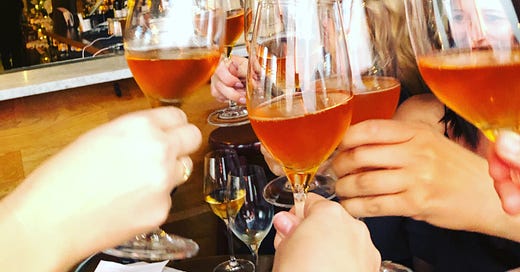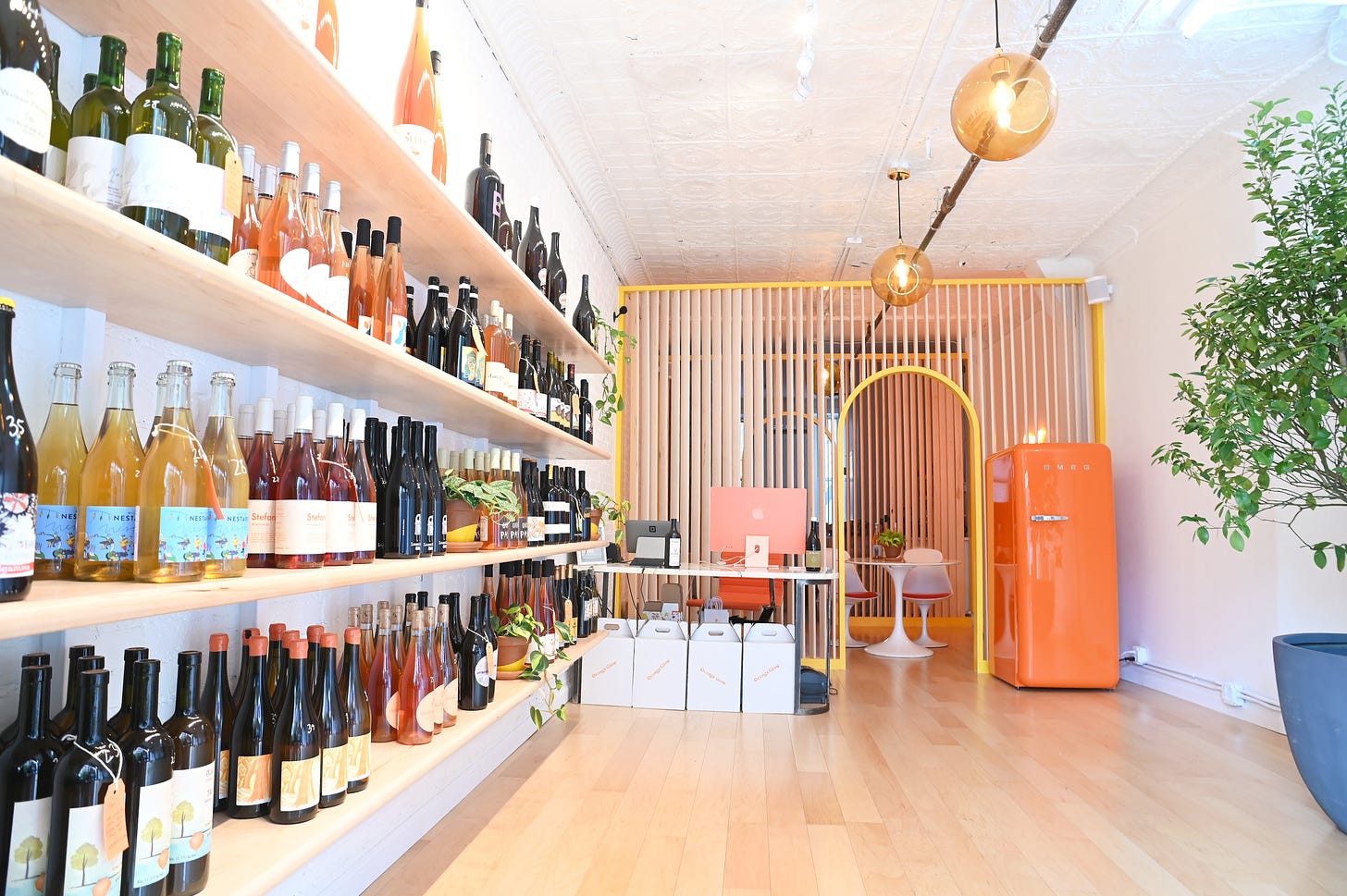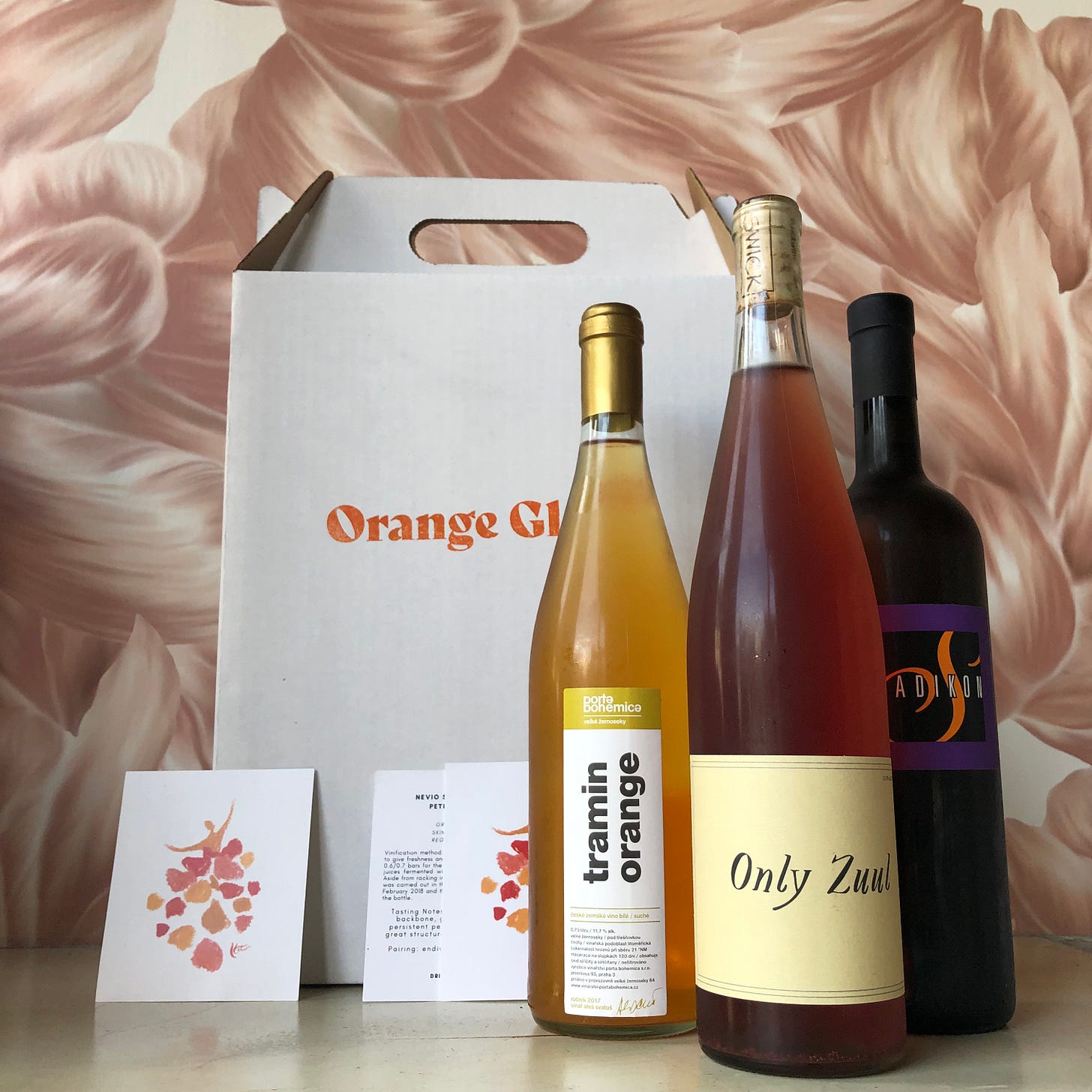It's Orange Wine Day!
Orange Glou founder and sommelier Doreen Winkler shares her favorites to drink
Friends,
There seems to be a “day” to celebrate everything – from bagels to ice cream to polenta. I am looking for one to celebrate people who can’t fold fitted sheets, but I can’t seem to find one. But we digress. Well, today happens to be Orange Wine day, a built-in excuse to not only open a bottle (or two) of the sunset-hued vino, but to learn a little about it.
I had the chance to chat with Doreen Winkler, named one of “America's Top Sommeliers” by Forbes, a natural wine expert. She’s the founder of Orange Glou, the world’s first and only wine store devoted exclusively to orange wines in New York City, the first orange wine subscription service, and the first orange wine event: the Orange Glou Wine Fair, now celebrating its third year in NY — it will be held on November 3rd in Union Square — and its first year in Los Angeles. So she’s got a lot to share.
Doreen and I chatted about everything you've always wanted to know about orange wine, but were afraid to ask – how it’s made, why it’s so special, what to drink today (and tomorrow!), and the winemaker from Slovenia you have to meet at the Orange Wine Far.
Andrea: What exactly is orange wine?
Doreen: This is an ancient style of wine. It is often foot-trodden [yes Lucy style], and the juice stays with the skins and the seeds and sometimes stems, and that’s why the color is not clear, it’s made the same as red wine is made, to leave the skins with the juice.
Can you share a little of its history?
It originated in the republic of Georgia, over 5000 years ago, with indigenous varieties and now it is everywhere in Italy, in Japan, and France and it's made from all sorts of grapes. I used to be like maybe Riesling is not the right grape but Božidar Zorjan, a great wine maker from Slovenia, he changed my mind. And he is going to be at the wine fair which makes me so happy! You have to try his wines and meet him.
There are many vessels used to age orange wine, it’s not just stainless steel barrels, right?
Yes, there are many vessels being used – the egg-shaped vessels from Georgia are called Qvevri are terracotta and traditionally buried underground. There are also clay amphoras in Italy, where they have also started to age wine in marble! There are cement casks and a lot of stuff out there. Also oak, obviously. They are doing this for all kinds of wine.
How did you get into orange wine?
I come from a classic sommelier background and got really into natural wine when I was the sommelier at Aska, Chef Fredrik Berselius’ two star Michelin restaurant in Williamsburg. We had a 19-course menu that had to be paired. The food was delicious but also very challenging for pairings because it was Scandinavian with lots of ingredients that were dehydrated, smoked, or pickled. Because of that pairing experience, I found that orange wine was always a good answer to the dishes. That made it interesting to me. I am a perfectionist and everything had to be perfect. The food was so amazing, and that’s how it started. I became fascinated with orange wine. Since then I’ve worked as a consultant to bring orange wines to wine lists at places like Aldea, Sel Rrose, Prime Meats, Lupulo,
What do you love about orange wine?
I really like the variety. To me orange wine is broader than white or red wine because there are several ways to make sparkling orange wine and it can be super refreshing and citrusy and some are more salty and savory.The whole bandwidth is so much stronger
At the shop we are able to share all the styles – we start with lighter sparkling to richer, and then light still to rich savory darker wines. There is so much variety In this small category and it is not even an official category yet. It still has to say white wine on the back label! It’s not approved as a category. Right now the categories are just sparkling, white, rose, red.
What is something you wish more people knew about orange wine
Everybody can find a wine in this group that they really enjoy. Also orange wine has the same health benefits as red wine because of the skin and seeds contact. It’s just a really exciting wine.
You started the Orange Wine Fair three years ago. Tell me about it.
It's a celebration of orange wine. There are other natural wine fairs, out there but mine is a bit different because it’s all orange wines, and it’s not the same winemakers every year. I try to have a different focus every year. This year we are highlighting orange wines from Austria, Slovenia and Italy, so it’s an opportunity to learn about the regions and varieties. I want people to see the whole spectrum of orange wine and taste the best and taste it all. So rather than have hundreds of wines, we keep the list to only about 100 wines, and we do two sessions and people can really taste at least 80 of them.
Tickets for the wine fair are on sale now; the prices are $65 for the 11am - 2:30pm session and $75 3pm - 6pm (all include a signature Orange Glou wine glass to keep).
Today is Orange Wine day – are you doing anything special?
Yes, we are offering a special wine duo available now till Oct. 31 – Orange Glou’s Wine Duet Box ($69), featuring 2 bottles with skin-contact ranging from 7 days to 3 weeks. It's not a beginner's set, but for your first try it gives you a good idea of what the wines can do.
We are also hosting an exciting Austrian Orange Wine Tasting Party on Friday October 18 from 6-9pm that will feature 15 delicious skin-contact wines from different regions of the country plus regional bites of charcuterie, cheeses, dips, mustards, pickled vegetables and pretzels.We are doing this special tasting party in our tasting room and new backyard! Tickets are $35, and $10 can be applied toward any purchases made that evening.
You also have an Orange Wine Subscription. Tell me about that..
This is a curated wine club that we have with 3, 6, or 12 bottles that change every month. We put the best stuff in there, from traditional and new discoveries, and something to age, something from all over the world. I put a lot of time in there in deciding what to include. The wines that I am working with are hard to get, so I am in touch directly with winemakers to see when their stuff is coming. That is a great beautiful gift wrapped with all the notes so you learn something too.
Okay now we need some advice on what to drink. Can you share three wines for Strong Buzz readers to try?
Sure! The skin contact time for these wines ranges from just two days to three weeks to six months, the hues from lemony yellow to dark orange, and the flavors from light and citrusy to bold and savory. Macerating the grape juice on the skins unlocks and intensifies different characteristics in these wines, including colors, textures and flavors, which will differ by grape variety too.
Sete ‘Bomba’ Frizzante, Lazio, Italy 2023 ($39)
The easiest way to get introduced to orange wine is with sparkling wines, and this delicious Sete Bomba Frizzante from Lazio, Italy is a light, bright, citrusy and beautiful way for anyone to begin their orange wine journey. How the length of skin contact affects the wine is grape dependent. For some grapes, three days of skin contact can lead to tannic results while 15 days will mellow out the flavor, and for other grapes it’s the other way around. With this Frizzante (Italian sparkling wine where secondary fermentation happens in the bottle), the two days of skin contact brings out a little bit more flavor from the indigenous Ottonese (aka Bombino Bianco) grapes to give the wine some tannins and body, and the color is on the lighter side of the wide orange wine color spectrum resembling lemon juice.
Petr Marada, Oranz Sauvignon, Czechia 2022 ($33)
Sauvignon Blanc is likely a grape people are already familiar with but trying a skin-macerated Sauvignon Blanc takes the flavor to a completely different level. With this Sauvignon from Petr Marada in Czechia, the three weeks of skin contact intensifies the natural flavor of the grape and brings out notes of pineapple and ginger that otherwise wouldn’t be present in the wine. It is medium bodied with a gorgeous golden color, and it’s a great example of how skin contact elevates and intensifies the flavor of the grape.
Ruth Lewandowski Chilion, California, USA 2022 ($49)
Cortese grapes are originally grown in Italy and used in a very popular white wine called Gavi, but this Ruth Lewandowski Chilion is a great way to explore how incredibly complex the variety is. This California-grown Cortese is a perfect example of how diverse orange wines are, as the extended six-month maceration process brings out these amazing savory and earthy notes that aren’t common in white wines. It’s a bold, full-bodied wine with a dark orange color that resembles the label and the wax, and it’s the perfect choice for red wine lovers who are getting into orange wines.







